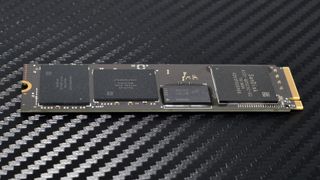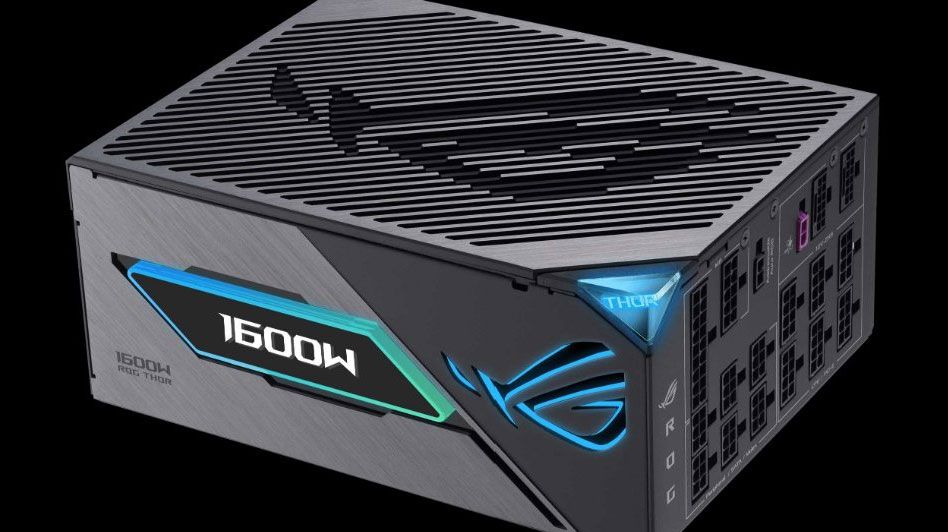Lovers of large SSDs rejoice, the WD Black SN850X 8TB reigns as the new champion of high capacity, high performance storage. Western Digital updated its popular Black SN850X SSD line to include an 8TB option, and it does not disappoint. There’s no longer a need to worry about making compromises on performance or power efficiency. What about the price? Well, you can’t have everything.
Or maybe you can. The 8TB WD Black SN850X is surprisingly price-competitive against existing 8TB options, considering it’s the better drive in almost every way. While we'd still like to see lower prices for 8TB drives, at least you’re getting better quality for your dollar with this one. The most cost-effective way to get 8TB of SSD storage is still two 4TB drives if you have the slots to spare, but if you absolutely need 8TB per slot then this is the drive for you. It’s also the best option to maximize the storage upgrade for your PS5, without the SN850P tax.
The SN850X 8TB isn't just “the same drive but bigger” compared to the earlier SN850X drives. WD spent some time on getting this drive right, upgrading the flash to get the most out of the hardware. This means you can jump from the 2TB or 4TB up to the 8TB without feeling you’ve lost anything. This isn’t the case with other 8TB options on the market, as those typically use slower flash at the highest capacity. There’s also been no change to the pSLC caching scheme, which means this drive can handle more than just games. It’s the all-around best 8TB SSD on the market.
WD Black SN850X Specifications
Swipe to scroll horizontally
| Pricing | w/HS | $79.98 | $97.63 | $153.69 | $139.99 | $309.99 | $356.61 | $849.99 | $899.99 |
| Form Factor | M.2 2280 SS | M.2 2280 SS | M.2 2280 DS | M.2 2280 DS |
| Interface / Protocol | PCIe 4.0 x4 / NVMe 1.4 | PCIe 4.0 x4 / NVMe 1.4 | PCIe 4.0 x4 / NVMe 1.4 | PCIe 4.0 x4 / NVMe 1.4 |
| Controller | Proprietary (Triton MP16+ B2) | Proprietary (Triton MP16+ B2) | Proprietary (Triton MP16+ B2) | Proprietary (Triton MP16+ B2) |
| DRAM | DDR4 | DDR4 | DDR4 | DDR4 |
| Flash Memory | Kioxia 112-Layer TLC (BiCS5) | Kioxia 112-Layer TLC (BiCS5) | Kioxia 112-Layer TLC (BiCS5) | Kioxia 162-Layer TLC (BiCS6) |
| Sequential Read | 7,300 MB/s | 7,300 MB/s | 7,300 MB/s | 7,200 MB/s |
| Sequential Write | 6,300 MB/s | 6,600 MB/s | 6,600 MB/s | 6,600 MB/s |
| Random Read | 800K IOPS | 1,200K IOPS | 1,200K IOPS | 1,200K IOPS |
| Random Write | 1,100K IOPS | 1,100K IOPS | 1,100K IOPS | 1,200K IOPS |
| Security | TCG OPAL 2.01 | TCG OPAL 2.01 | TCG OPAL 2.01 | TCG OPAL 2.01 |
| Endurance (TBW) | 600TB | 1,200TB | 2,400TB | 4,800TB |
| Part Number | w/HS | WDS100T2X0E WDS100T2XHE | WDS200T2X0E WDS200TXHE | WDS400T2X0E WDS200TXHE | WDS800T2X0E WDS200TXHE |
| PS5-Compatible HS | Yes | Yes | Yes | Yes |
| Dimensions w/HS | 80mm (L) x 23.4mm (W) x 8.9mm (H) | 80mm (L) x 23.4mm (W) x 8.9mm (H) | 80mm (L) x 24.46mm (W) x 10.31mm (H) | 80mm (L) x 24.46mm (W) x 10.31mm (H) |
| Warranty | 5-Year | 5-Year | 5-Year | 5-Year |
When we initially reviewed the
WD Black SN850X, it was only available in 1TB, 2TB, and 4TB capacities. Today, we’re looking at the new 8TB SKU, which is a bit of a niche product given the capacity and cost. Right now it runs
$879 without a heatsinkand
$899 with a heatsink(note that
Newegg lists the non-heatsink variant for $799, but it's currently backordered). That's certainly a high premium, considering the
4TB SN850X costs $302, but it's not too outrageous given the cost of other 8TB M.2 drives. The 8TB
Inland Performance Plusand
Inland Gaming Performance Plus, the latter coming with a heatsink, currently run $859.99 and $889.99 by way of comparison.
WD represents a well-known brand, so it’s generally priced fine. However, we have to call out the heatsink nonsense. $50 to $100 extra for a heatsink that you can match or beat with a $10–$20 aftermarket part? Check our recent
M.2 heatsinkreview for testing and recommendations, but we'd stick to the non-heatsink option unless you just really love having the WD Black branding and design (hidden away in your PC) — or you want the built-in RGB that WD provides.
The new 8TB SKU comes with new flash — BiCS6 instead of BiCS5, although this flash may trickle its way down into the existing, smaller-capacity SKUs — and as a result has somewhat surprising performance marks. The drive can deliver up to 7,200 / 6,600 MB/s for sequential reads and writes, with reads only slightly lower than the old peak, and up to 1,200K / 1,200K random read and write IOPS, with writes exceeding the old peak. That's surprising because there’s often a hit to performance when going to 8TB with drives in this class, but the swap to newer flash helps out. This is not only because the newer flash has architectural improvements but because it’s denser, too, so there’s no increase in the die count or corresponding overhead.
Everything else is as expected with 600TB of writes under the five-year warranty for every TB capacity. That’s good, because this drive will be popular with enthusiasts and content creators who may push the drive harder than normal for many years to come.
WD Black SN850X Software and Accessories
As with the original Black SN850X, the 8TB model supports WD’s Digital Dashboard management software and with support from
Acronis True Image for Western Digital. The Digital Dashboard in this case acts as an SSD toolbox with health and diagnostic information as well as important feature support. This includes support for firmware updates and, if you get the heatsink model of the drive, control for the RGB lighting. Acronis True Image is for data backup, drive imaging, and drive cloning, quite useful when installing a new drive.
For the SN850X, one salient feature is Game Mode 2.0 as an improvement to the original Game Mode found on the older
WD Black SN750. The original Game Mode acted by disabling lower power states to improve drive responsiveness. Game Mode 2.0 takes this further with algorithms designed to smooth out performance to avoid unnecessary “lag” spikes. While not a necessary feature, it may have application in some cases with upcoming games that require better storage performance.
WD Black SN850X: A Closer Look

The most pertinent thing about this drive is that, like the 4TB, it’s double-sided. It’s probably too soon to expect any single-sided 8TB drives, but with only two NAND flash packages per side that's even more of an ask. Samsung does manage 4TB single-sided with that configuration in the
Samsung 990 Pro, but even popular drives like the Crucial T500 are going double-sided at that capacity, let alone 8TB. It’s certainly possible to do 8TB single-sided with four flash packages on a DRAM-less drive, but we haven’t seen it yet. The
Teamgroup MP44is ostensibly DRAM-less at all capacities according to Team’s website and our table at the time of review, but it’s more likely equipped with the Phison E18 SSD controller that has DRAM and is therefore definitely double-sided.
There are reasons for this. One is that DRAM-less drives are meant to be budget-oriented, which puts 8TB out of reach. Even if 8TB made sense, using more packages would probably be easier. Furthermore, DRAM-less controllers usually have only half the channels of DRAM-equipped controllers — four instead of eight — which makes it more challenging to drive that much flash. Even the T500, which has DRAM but just four channels, needs extra ICs for its 4TB SKU, in part for the higher-speed flash needed to saturate the interface. We will probably need to see 2Tb dies — which will come first with QLC flash — before single-sided 8TB becomes commonly available.

The two changes here are the controller, A101-000292-B2 rather than the 20-82-20035-V2 on the original Black SN850X we reviewed, and the flash, which through decoding we can determine is BiCS6. Note the “G” in the string instead of the “C” for the old BiCS5. As for the controller, it’s possibly an update to the original but with a higher bus rate for better flash compatibility, but the technology is largely the same.
We’ve previously praised WD’s controllers, with SanDisk technology, for being well-optimized for power efficiency and performance, particularly in getting good latency out of BiCS flash. This is in part due to the multi-gear LDPC error correction, although all modern controllers are using LDPC instead of BCH these days. The general idea is to correct bit errors with the best balance of performance and latency, power efficiency, and cost in terms of die space. Usually LDPC for SSDs will work from less-intensive to more-intensive correction, depending on how degraded the data in question might be. Initial hard-decision decoding is fast for low error rates, then progressive soft-decision decoding can assist with a higher error rate. Latency, particularly read latency, will increase as error correction becomes necessarily more complex for particularly worn cells.
Multi-gear LDPC works by having different decoding algorithms or rules — gears — that can be applied with iterative passes, which can mean corrections that better fit the particular data errors at hand. This is important as different blocks of data may have different wear characteristics and correction requirements. The controller can be selective in how it approaches different data by compensating for known error causes and adapting to specific data locations based on feedback and training, but this increases complexity. There are always trade-offs, in part because correction parallelization has to be adapted in an optimal way to reduce latency and power consumption and make the best use of limited silicon that’s specialized for NAND flash peculiarities. As flash increases in layer and bit counts, this becomes more important in ensuring sufficient endurance.
To avoid digging deeper into this complicated subject, the point of bringing up ECC here is that some drives have been known to have rather poor read performance after some time with stale data. Most recently we heard about this with the
Kingston Fury Renegadeand
KC3000, with the issue first mentioned in our
Kingston NV3 review. Over time, the bit error rate will increase from leakage and similar phenomenon — there are many things that can impact data retention, including temperature and wear — and the data should be refreshed at regular intervals to prevent performance loss due to the increased need for correction.
This might be why the Kingston firmware update release notes suggest “improved decoding flow to prevent excessive latency.” While Kingston is working with the licensed Phison E18 SSD controller on those drives, WD is able to work hand-in-hand with its flash and proprietary technology to squeeze out more performance, and this is one possible way it can do so. This is particularly relevant for the 8TB SN850X as its main competition would be 8TB E18-based SSDs.
MORE: Best SSDs
MORE: How We Test HDDs And SSDs
MORE: All SSD Content

 1 day ago
2
1 day ago
2





:quality(85):upscale()/2024/10/17/848/n/1922729/9dece426671163b35dcb11.60305022_.jpg)


 English (US) ·
English (US) ·